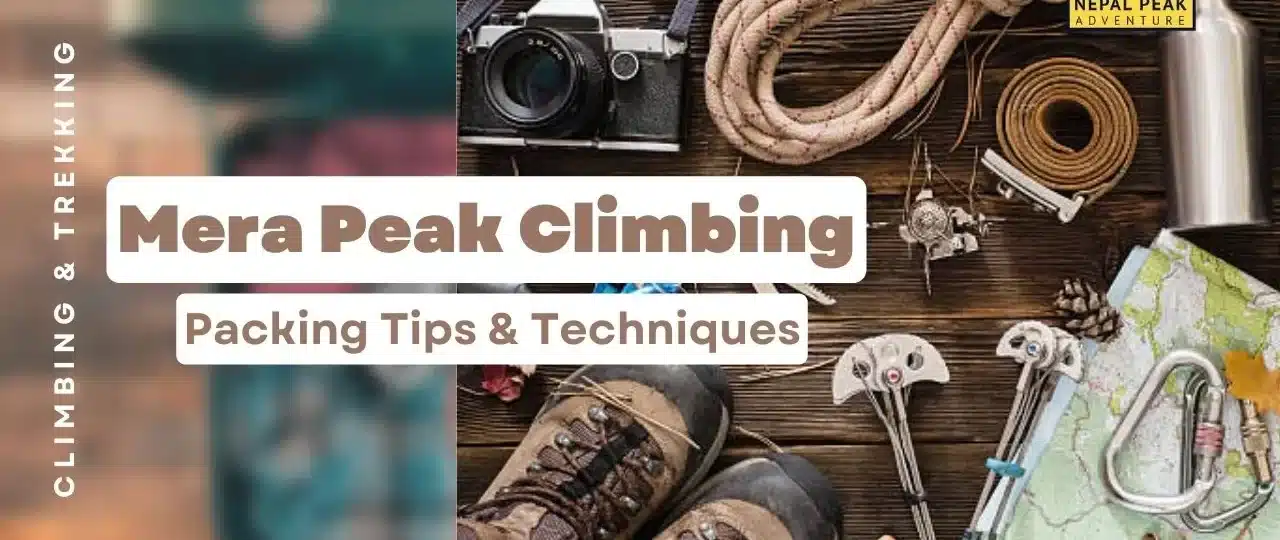Ultimate Mera Peak Packing List: Gear up for an Adventure of a Lifetime
Mera Peak, located in the Solu Khumbu region of Nepal, stands tall at an impressive elevation of 6,476 meters (21,246 feet). Renowned as the highest trekking peak in Nepal, Mera Peak attracts adventurers from around the world. Its popularity stems from the stunning panoramic views it offers, including the mighty Himalayan peaks such as Everest, Lhotse, Cho Oyu, and Makalu.
To ensure a successful and safe Mera Peak expedition, it is crucial to have a well-prepared Mera Peak packing list. In this article, we will provide a comprehensive guide to help you pack effectively for this awe-inspiring adventure.
Table of Contents
Understand the Importance of a Well-Prepared Mera Peak Packing List:
A well-prepared peak equipment is the cornerstone of any successful trekking expedition, and Mera Peak is no exception. The remote and rugged nature of this trek demands careful planning and preparation. Here are a few reasons why a comprehensive Mera Peak Gear list is essential:
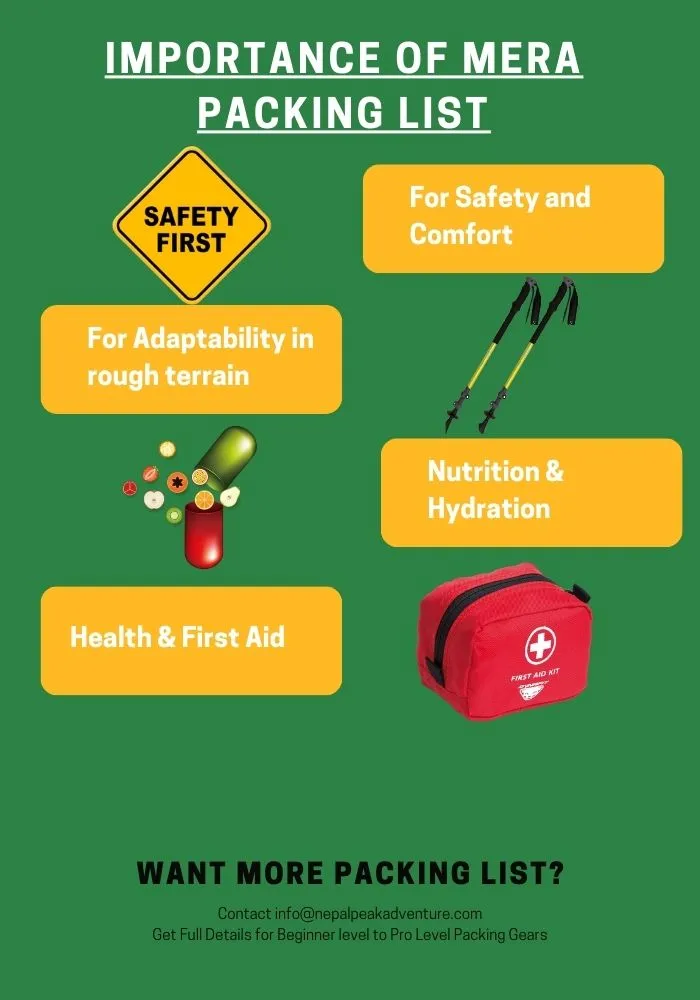
For Safety and Comfort: A well-thought-out packing list will include essential gear and equipment to keep you safe and comfortable during the trek. Proper clothing, sturdy footwear, and suitable sleeping gear are vital to protect against extreme weather conditions. There are multiple choices of peak gears in the market but choose what you are comfortable with and train for peak climbing with those gears.
For Adaptability: Mera Peak trek presents diverse terrain, including glaciers, rocky trails, and steep ascents. Packing the right gear, such as crampons, ice axes, and trekking poles, will enhance your adaptability to different terrains and ensure a smoother journey.
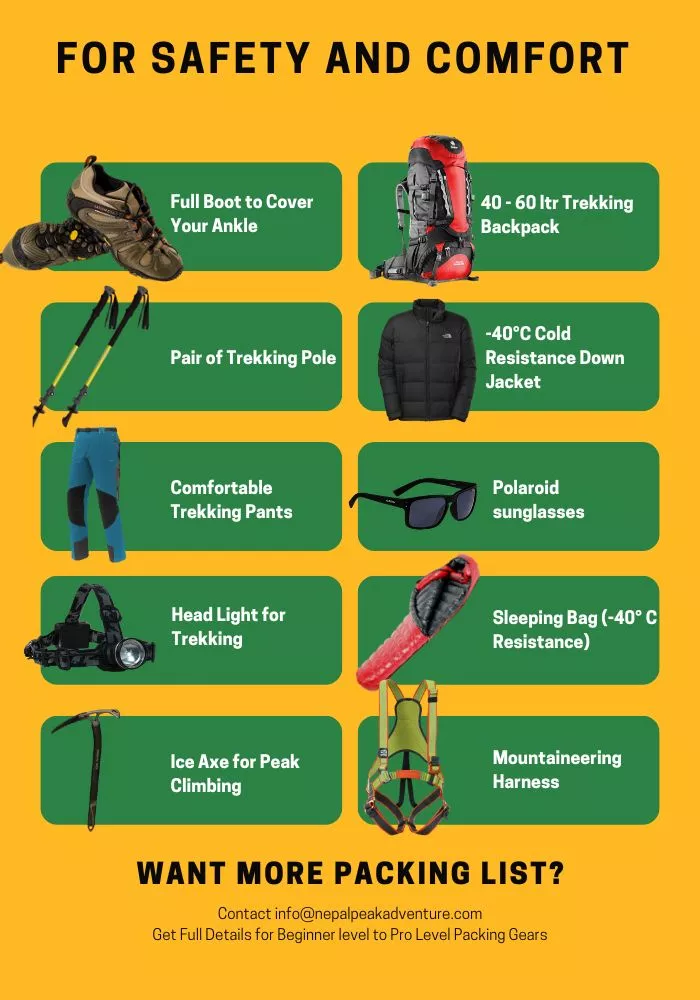
Nutrition and Hydration: Trekking at high altitudes requires careful attention to nutrition and hydration. Your packing list should include energy-rich snacks, water purification tablets, and a reusable water bottle to keep you nourished and hydrated throughout the trek. Also, know more about “Food & Lodging during trekking in Nepal” to be more prepared.
Health and First Aid: Being well-prepared with a comprehensive first aid kit, including altitude sickness medication, bandages, painkillers, and any personal medications, is vital for your well-being. This ensures prompt attention to any minor injuries or health issues that may arise during the trek.
The purpose of this article is to provide you with a comprehensive packing list for your Mera Peak climbing adventure in Nepal. We understand the significance of having the right equipment, clothing, and supplies for a successful and enjoyable adventure. By following our carefully curated Mera Peak packing list, you can be well-prepared to face the challenges of Mera Peak and fully immerse yourself in the beauty of the Himalayas.
Clothing and Footwear for Mera Peak
Layering System:
When preparing for the Mera Peak, it is crucial to have a well-designed layering system that allows you to adapt to changing weather conditions. Here are the key components:
Base Layers: Choose moisture-wicking, quick-drying base layers made of synthetic or merino wool material. These include long-sleeved tops and bottoms that provide insulation and help regulate body temperature.
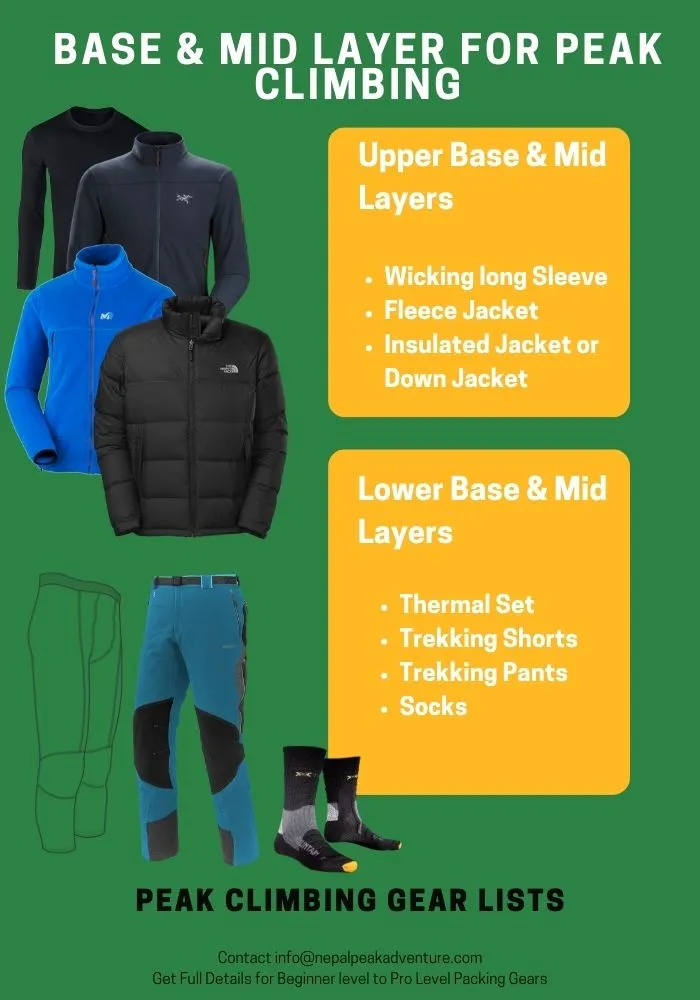
Mid-Layers: Pack a variety of mid-layers such as fleece jackets, lightweight sweaters, or softshell jackets. These add warmth and can be easily added or removed as needed.
Outer Layers: Have a waterproof and windproof outer layer, such as a hardshell jacket and pants, to protect against rain, snow, and strong winds. Ensure they have proper ventilation options to prevent overheating during strenuous activities.
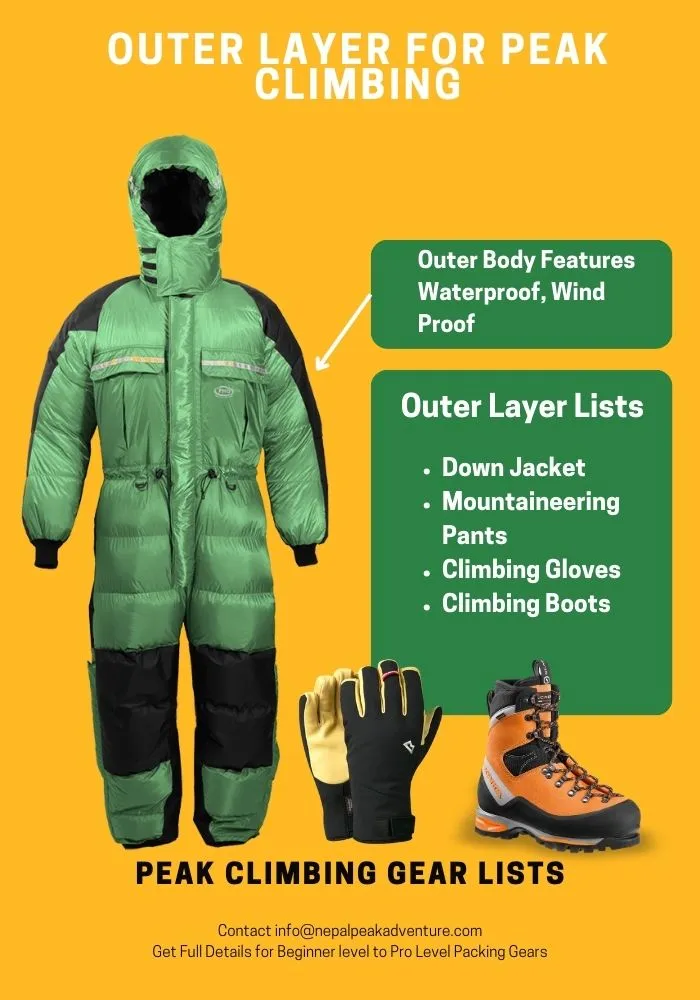
Insulated Jacket and Sleeping Bag:
Temperatures can drop significantly during the Mera Peak climbing, especially at higher altitudes. It is essential to pack the following items to keep warm:
Insulated Jacket: A high-quality insulated jacket, preferably down or synthetic-filled, provides an excellent warmth-to-weight ratio. Look for lightweight and compressible options that can be easily packed in your backpack.
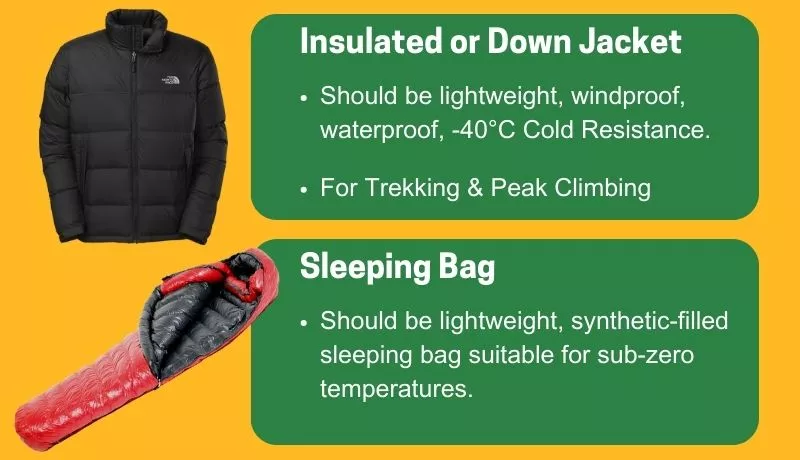
Sleeping Bag: Invest in a down or synthetic-filled sleeping bag that is suitable for sub-zero temperatures. Check the comfort rating and ensure it is specifically designed for cold-weather camping. A compression sack will help reduce its size for easy transport.
Trekking Pants and Waterproof Trousers:
Selecting the right pants for the Mera Peak trek is important for comfort and protection. Consider the following:
Trekking Pants: Opt for lightweight, quick-drying pants with a comfortable fit. Look for options with zip-off legs to convert them into shorts for warmer days. Multiple pockets are handy for storing essentials.
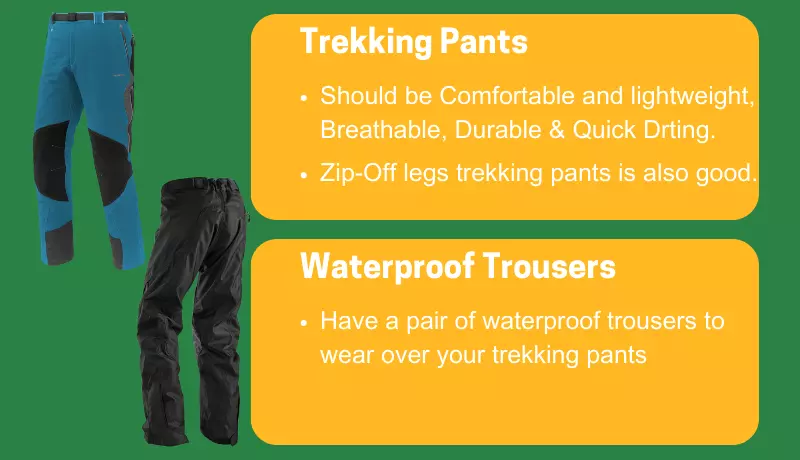
Waterproof Trousers: Have a pair of waterproof trousers to wear over your trekking pants when it rains or snows. These will keep you dry and protected from moisture.
Handwear – Gloves
Choosing the right gloves is crucial for protecting your hands from the cold temperatures and harsh conditions encountered during the Mera Peak climb. Here are some key considerations:
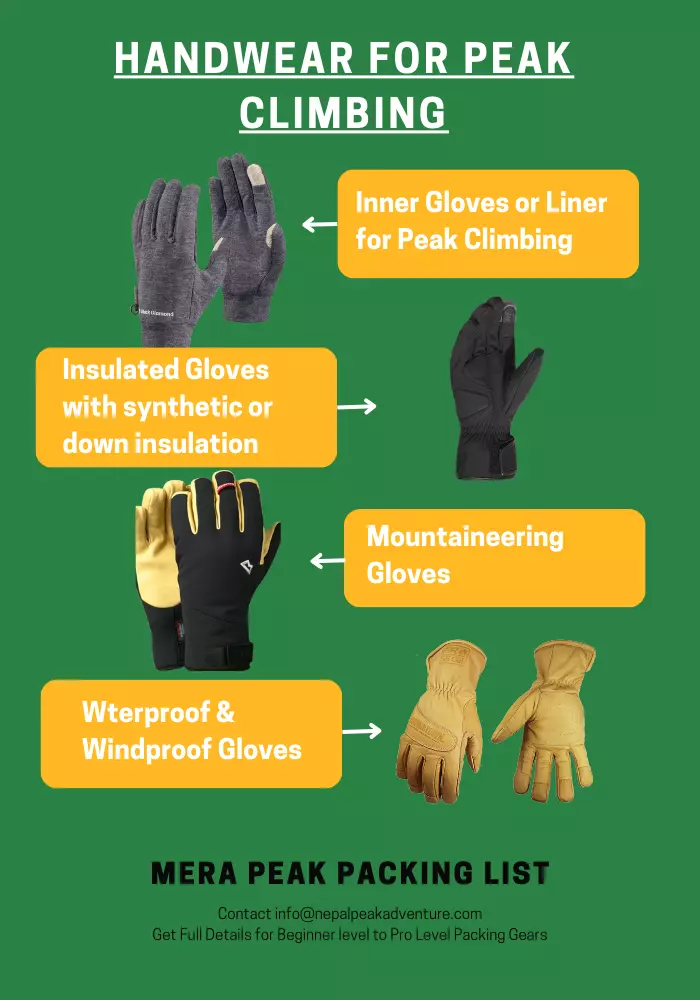
Inner Gloves or Liners: Inner gloves or liners are lightweight, form-fitting gloves worn underneath your outer gloves. They provide an additional layer of insulation and help wick away moisture from your hands. Liners are particularly useful during colder conditions or when you need extra dexterity.
Insulated Gloves: Insulated gloves are designed to provide warmth in cold temperatures. Look for gloves with synthetic or down insulation, which offer an excellent warmth-to-weight ratio. Ensure that they are waterproof or at least water-resistant to protect your hands from snow, rain, and moisture.
Waterproof and Windproof Gloves: It’s important to have a pair of gloves that are both waterproof and windproof. These gloves are typically made with a durable outer shell and a waterproof membrane, such as Gore-Tex, to keep your hands dry and shielded from strong winds.
Mountaineering Gloves: For the higher altitudes and more extreme weather conditions encountered during the Mera Peak climb, consider using mountaineering gloves. These gloves are specifically designed for alpine climbing and offer superior insulation, durability, and protection against harsh elements. They often have reinforced palms and fingers for added grip and durability.
Extra Gloves: It’s a good idea to carry an extra pair of lightweight gloves as a backup in case your primary gloves get wet or damaged. These gloves can serve as a spare or as an additional layer for added warmth during colder sections of the trek.
Comfortable and Durable Hiking Boots:
Proper footwear is essential to handle the rugged terrain and long hours of trekking. Pay attention to the following aspects:
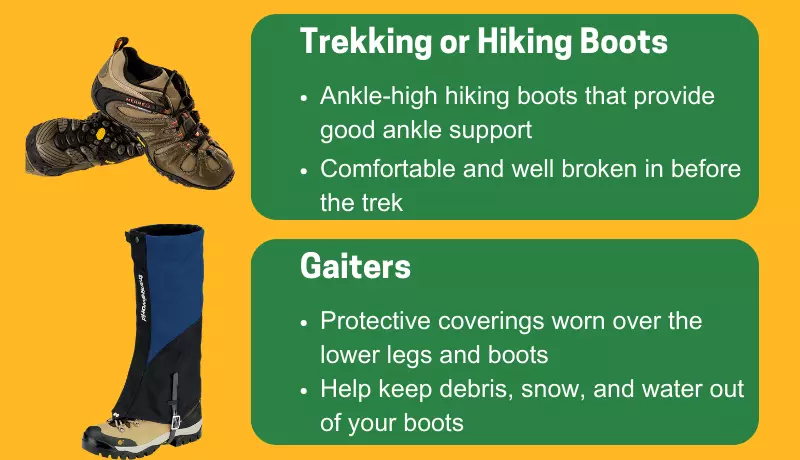
Hiking Boots: Invest in sturdy, ankle-high hiking boots that provide good ankle support, traction, and stability. Ensure they are comfortable and well broken in before the trek to prevent blisters and discomfort.
Gaiters: Consider wearing gaiters, which are protective coverings worn over the lower legs and boots. They help keep debris, snow, and water out of your boots, providing extra protection and comfort.
Quality Socks:
Wearing suitable socks is crucial for foot comfort and the prevention of blisters. Consider the following:
Hiking Socks: Choose high-quality, moisture-wicking hiking socks made of merino wool or synthetic materials. They should provide cushioning, support, and moisture control.
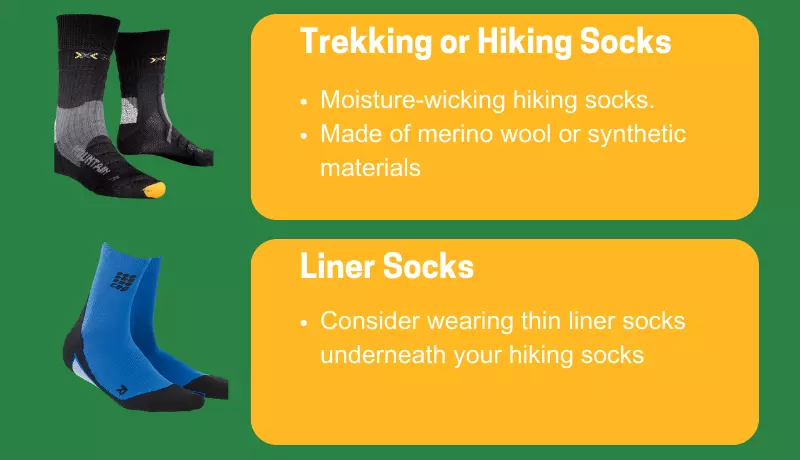
Liner Socks: Consider wearing thin liner socks underneath your hiking socks to reduce friction and minimize the risk of blisters.
By paying attention to your clothing, handwear, and footwear choices, you can stay comfortable, protected, and ready to conquer the challenges of the Mera Peak trek.
Backpack and Gear List for Mera Peak
Selecting an Appropriate Backpack:
Choosing the right backpack is crucial for comfortably carrying your gear throughout the Mera Peak trek. Consider the following factors:
Capacity: Select a backpack with a capacity suitable for multi-day trekking. Depending on the duration of your trek and the amount of gear you need to carry, a backpack with a capacity of 50-70 liters should be sufficient.
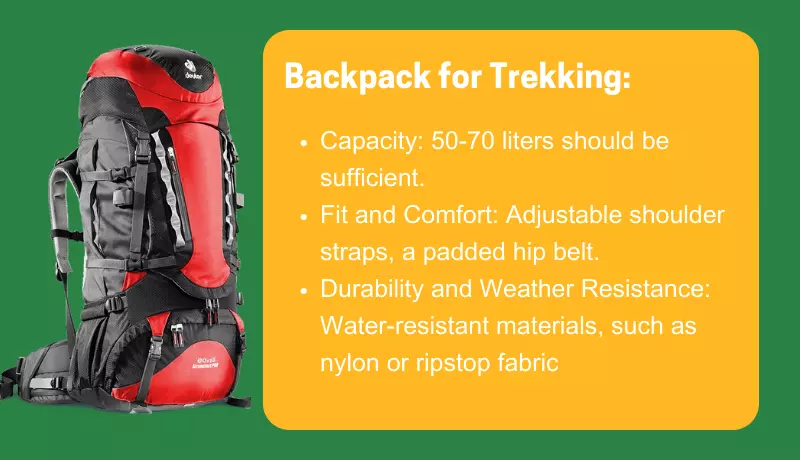
Fit and Comfort: Look for a backpack that offers adjustable shoulder straps, a padded hip belt, and a back panel with good ventilation. Ensure the backpack fits well and distributes the weight evenly to prevent discomfort and strain on your back.
Durability and Weather Resistance: Opt for a backpack made of durable and water-resistant materials, such as nylon or ripstop fabric. This will protect your gear from moisture and ensure the backpack withstands the demands of the trek.
Lightweight and Compact Camping Gear:
Carrying lightweight and compact camping gear is essential to minimize the weight of your backpack. Here are some key items to consider:
Tent: Choose a lightweight and easy-to-set-up tent suitable for the Mera Peak trek. Look for a model that provides good weather resistance and adequate space for you and your trekking partner.
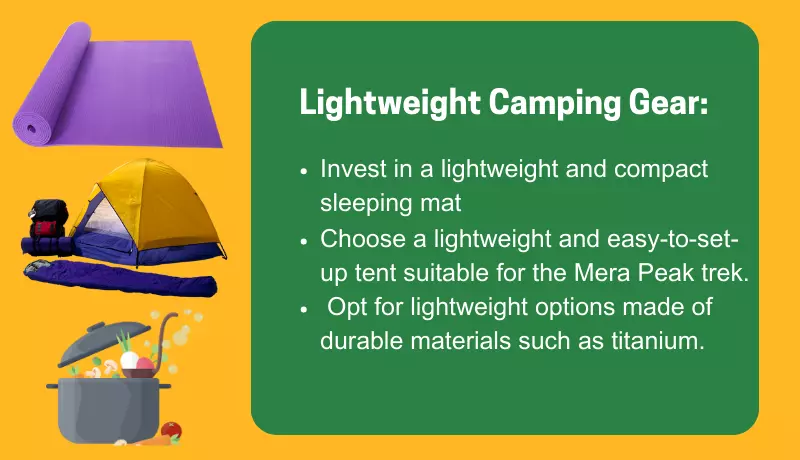
Sleeping Mat: Invest in a lightweight and compact sleeping mat that offers insulation and comfort. Look for options with an R-value suitable for cold weather conditions.
Cooking Equipment: Carry a lightweight and compact cooking stove, cooking pot, and utensils for preparing meals during the trek. Opt for lightweight options made of durable materials such as titanium.
Trekking Poles:
Trekking poles are invaluable for providing stability, balance, and support during the Mera Peak trek. Look for adjustable and collapsible poles made of lightweight materials such as aluminum or carbon fiber. Ensure they have comfortable grips and sturdy locking mechanisms.
Portable Water Filtration System:
Access to safe drinking water is crucial during the trek. Carry a portable water filtration system, such as a water filter or water purification tablets, to treat water from natural sources along the trail. This will ensure a constant supply of clean and safe drinking water.
Personal Hygiene Essentials:
Maintaining personal hygiene is important during the trek. Pack the following essentials:
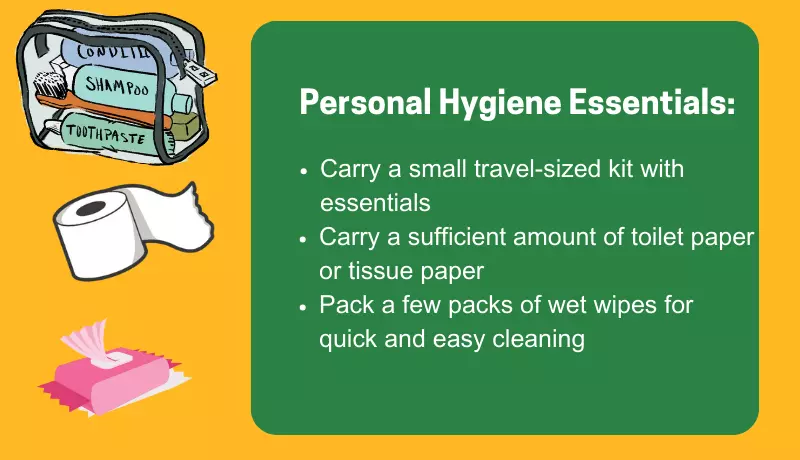
Toiletries: Carry a small travel-sized kit with essentials such as a toothbrush, toothpaste, biodegradable soap, and a quick-drying towel.
Toilet Paper: Carry a sufficient amount of toilet paper or tissue paper as it may not be readily available along the trail.
Wet Wipes: Pack a few packs of wet wipes for quick and easy cleaning when access to water is limited.
By carefully selecting a suitable backpack, carrying lightweight and compact camping gear, and including essential items like trekking poles, a water filtration system, and personal hygiene essentials, you’ll be well-equipped for the challenges of the Mera Peak trek.
Mera Peak Gear List and Climbing Equipment List
When preparing for the ascent of Mera Peak Summit, it is crucial to have the right climbing gear and equipment to ensure your safety and success. Here are some essential items to consider:
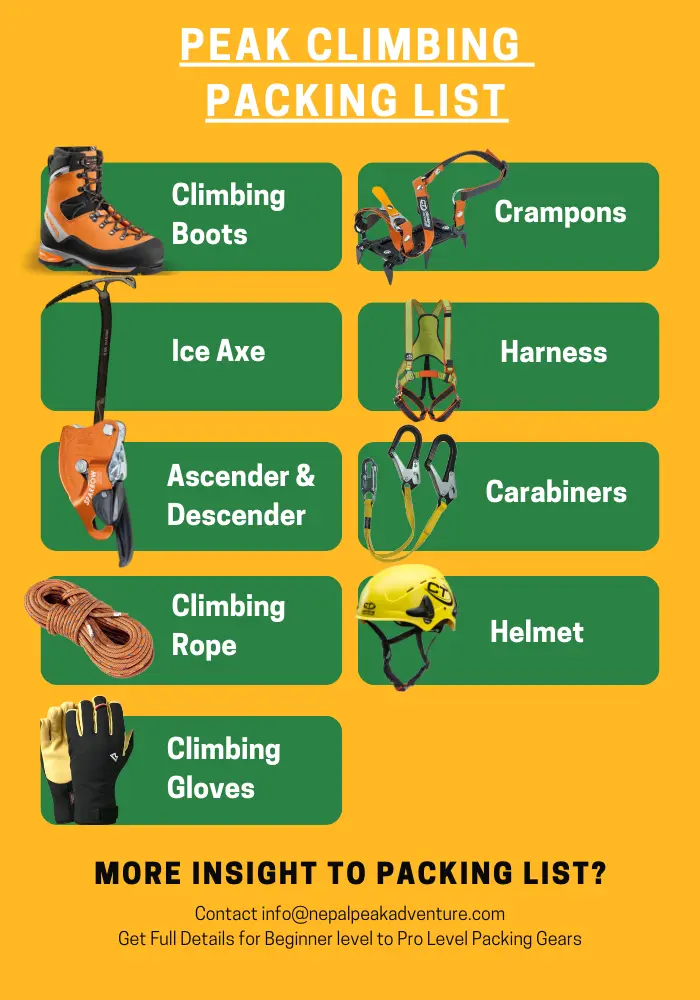
Mountaineering Boots: Invest in high-quality mountaineering boots suitable for cold and icy conditions. These boots should have rigid soles, excellent ankle support, and compatibility with crampons.
Crampons: Crampons are essential for traversing icy and snowy terrain. Ensure they are compatible with your mountaineering boots and have anti-balling plates to prevent snow from accumulating underneath.
Ice Axe: An ice axe is crucial for stability and self-arresting in case of a slip or fall on steep slopes. Choose a suitable length and weight that allows for effective use during the climb.
Harness and Climbing Helmet: Wear a climbing harness for safety during technical sections and for attaching yourself to ropes. A climbing helmet is also essential to protect your head from falling objects and potential impacts.
Ascender and Descender Devices: Depending on the climbing route and technical requirements, you may need ascender and descender devices. These tools assist in rope management during steep sections and provide additional security.
Carabiners and Slings: Carry a selection of carabiners and slings for attaching yourself to fixed ropes, anchors, and other climbing equipment. They are essential for securing your position and creating anchor points when needed.
Rope: Consult with your trekking agency to determine if you need to carry your own rope. If required, select a suitable length and diameter for the climbing sections. Ensure the rope is in good condition and has proper strength ratings.
Climbing Helmet: Wear a climbing helmet to protect your head from potential falling rocks, ice, or other hazards during the climb. Choose a lightweight and comfortable helmet that meets safety standards.
Climbing Gloves: Invest in sturdy and durable climbing gloves that provide grip and protection. They should offer dexterity while maintaining warmth and durability in harsh conditions.
It is essential to have proper training and experience in using climbing equipment before attempting the ascent of Mera Peak. If you are inexperienced or unfamiliar with using this equipment, it is highly recommended to hire an experienced guide or join a guided expedition.
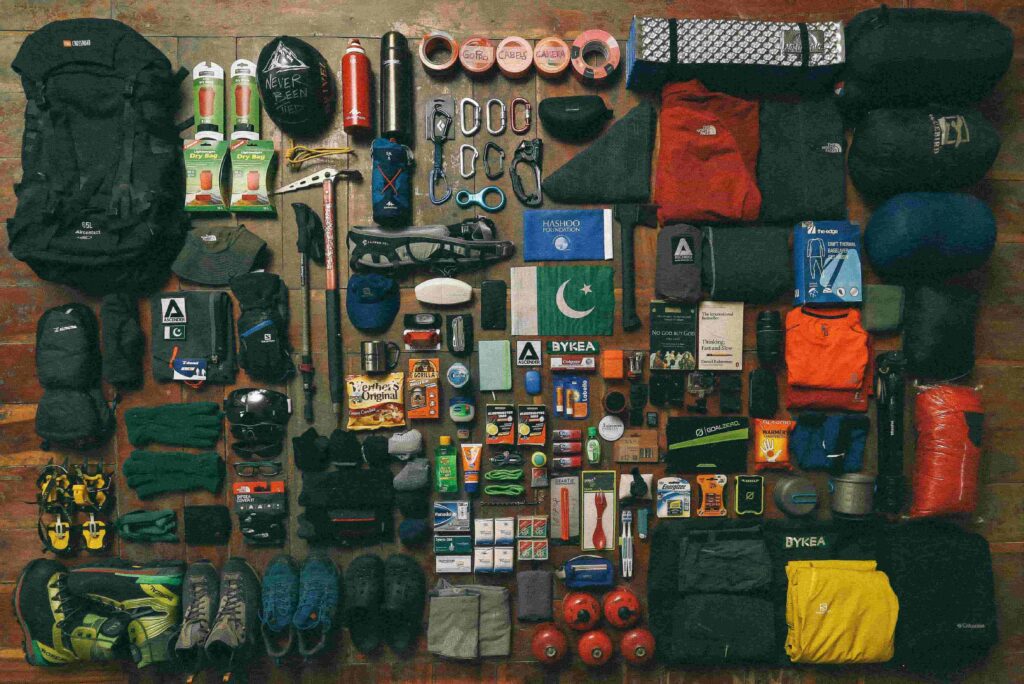
Mera Peak Packing List: Miscellaneous Items
In addition to the essential gear and equipment, there are several miscellaneous items that you should include when preparing for the Mera Peak climb. Here are some important ones to consider:
Headlamp with Extra Batteries: A reliable headlamp is essential for navigating in low-light conditions or during early morning starts. Make sure to pack extra batteries to ensure you have sufficient power throughout the trek.
Cash and Necessary Travel Documents: Carry sufficient cash in Nepalese currency for any expenses along the trail, such as meals, snacks, and souvenirs. Additionally, bring important travel documents such as your passport, permits, identification, and travel insurance details.
Trekking Permits and Licenses: Ensure you have all the required permits and licenses for the Mera Peak trek. This typically includes a Sagarmatha National Park permit, a Mera Peak climbing permit, and any other necessary documents. Keep them easily accessible in a waterproof pouch or bag.
Lightweight and Quick-Drying Towel: Pack a compact, lightweight, and quick-drying towel for personal hygiene and drying off after washing. Microfiber towels are a popular choice due to their absorbency and quick-drying properties.
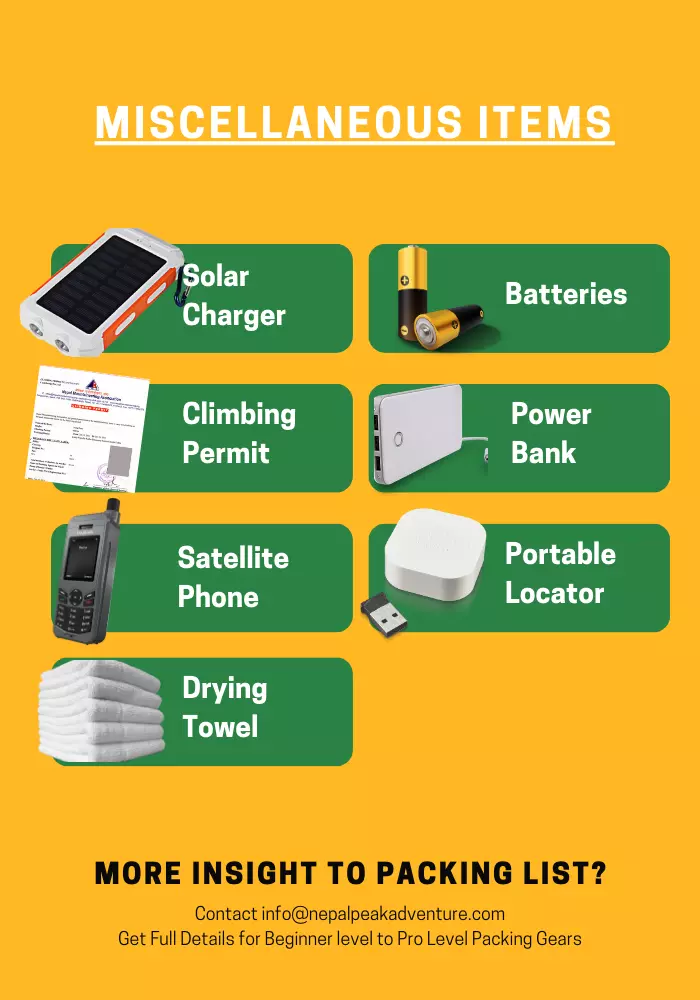
Spare Laces and Repair Kit for Hiking Boots: It’s always a good idea to carry spare laces for your hiking boots in case they break or get damaged. Additionally, pack a basic repair kit that includes items like adhesive, duct tape, and a multi-tool for on-the-go repairs.
Portable Power Banks: Carry one or more portable power banks to keep your devices charged throughout the trek. Look for power banks with high capacity and multiple charging ports to accommodate your smartphone, camera, and other electronic devices. Opt for lightweight and compact options that are easy to carry in your backpack.
Solar Chargers: Another option is to have a solar charger that utilizes solar energy to recharge your devices. This can be particularly useful during longer treks where access to electricity may be limited. Choose a solar charger with a high wattage and efficient solar panels to ensure effective charging even in cloudy conditions.
Satellite Phone: Carrying a satellite phone allows you to make calls and send messages even in remote areas where regular cellular networks are unavailable. Satellite phones provide a reliable means of communication for emergencies or if you need to contact your trekking agency, rescue services, or loved ones.
Personal Locator Beacon (PLB): A personal locator beacon is a small, portable device that can be activated to send distress signals via satellite. It allows search and rescue teams to locate you in case of an emergency. PLBs are particularly useful in remote areas where communication is challenging.
These miscellaneous items may seem small, but they play a crucial role in ensuring your comfort, safety, and convenience during the Mera Peak trek. Be sure to double-check and pack them before your departure.
Mera Peak Packing List Tips and Techniques
Packing efficiently and thoughtfully can make a significant difference in the comfort and ease of your Mera Peak trek. Here are some helpful packing tips and techniques to consider:
Use a Packing List: Create a comprehensive packing list that includes all the essential items you will need for the trek. This will help you stay organized and ensure that you don’t forget anything important.
Prioritize Lightweight and Compact Gear: Opt for lightweight and compact versions of your gear and equipment. This will reduce the overall weight of your backpack and make it easier to carry during the trek. Choose gear made from lightweight materials without compromising on quality and durability.
Pack in Layers: Utilize the layering system when packing your clothing. This allows you to adjust your clothing according to the weather conditions and your activity level. Place the items you will need first at the top of your backpack for easy access.
Roll Your Clothing: Rolling your clothing items instead of folding them can save space and minimize wrinkles. It also helps in organizing and finding specific items quickly.
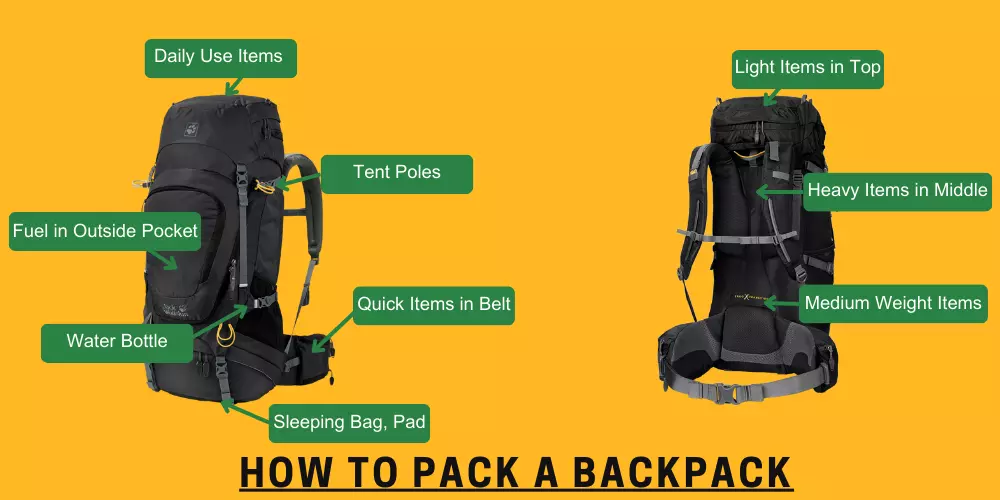
Use Compression Bags or Packing Cubes: Compression bags or packing cubes can help compress your clothing and keep it neatly organized. They also maximize space utilization and make it easier to locate items without unpacking everything.
Keep Essentials Easily Accessible: Pack your frequently used items such as snacks, water bottles, sunscreen, and a rain jacket in external pockets or the top compartment of your backpack. This way, you can quickly access them without having to dig through your entire backpack.
Distribute Weight Properly: Place heavier items closer to your back and towards the middle of your backpack to maintain better balance and stability. This will prevent strain on your back and help you maintain a comfortable posture during the trek.
Use Waterproof or Dry Bags: Invest in waterproof or dry bags to protect your gear, especially electronics, documents, and clothing, from moisture, rain, and snow. These bags provide an extra layer of protection and help keep your belongings dry.
Pack Multi-Purpose Items: Choose gear and items that serve multiple purposes. For example, a buff can be used as a hat, headband, or neck warmer. This helps reduce the number of individual items you need to pack.
Leave Room for Souvenirs: If you plan to bring back souvenirs or mementos from your trek, leave some extra space in your backpack or consider carrying a foldable daypack to accommodate them.
Remember to keep the weight of your backpack manageable and distribute the load evenly to avoid unnecessary strain or discomfort during the trek. It’s also a good idea to test and adjust your packed backpack before the trek to ensure a comfortable fit.
Researching and Planning the Trek:
Before embarking on your Mera Peak trek, thorough research and planning are essential to ensure a smooth and successful journey. Here are some key aspects to consider:
Trekking Agency: Research and choose a reputable trekking agency that specializes in Mera Peak expeditions. Read reviews, compare prices, and ensure they have experienced guides who are familiar with the route and safety protocols.
Permits and Documentation: Obtain the necessary permits and documentation required for the trek. This typically includes a Sagarmatha National Park permit and a Mera Peak climbing permit. Check with your trekking agency for specific requirements.
Itinerary: Plan your itinerary in advance, considering factors such as acclimatization days, rest days, and estimated trekking distances. A well-designed itinerary will help you pace yourself and increase your chances of a successful summit attempt.
Training and Fitness: The Mera Peak trek is physically demanding, so it’s important to be adequately prepared. Engage in cardiovascular exercises, strength training, and hiking to build stamina and endurance. Consult with a fitness professional for a tailored training program.
Choosing the Right Season and Understanding Weather Conditions:
Selecting the appropriate season for your Mera Peak trek is crucial for a safe and enjoyable experience. Consider the following factors:
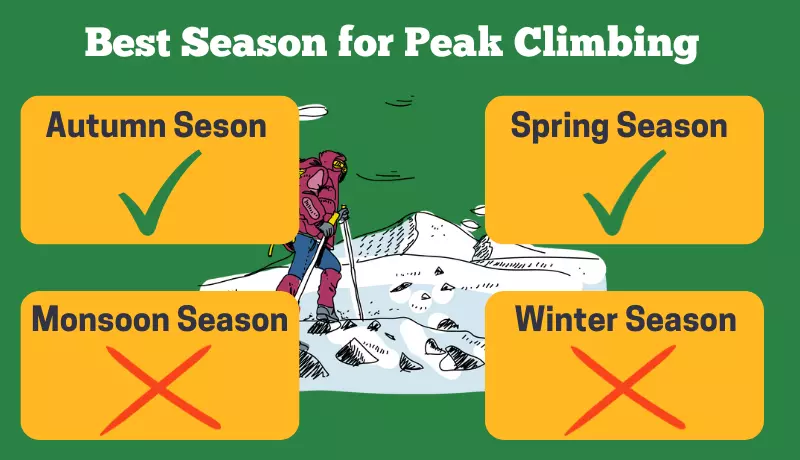
Peak Season: The most popular seasons for the Mera Peak trek are the pre-monsoon (spring) season (March to May) and the post-monsoon (autumn) season (September to November). During these periods, the weather is relatively stable, with clear skies and favorable trekking conditions.
Weather Conditions: Familiarize yourself with the typical weather patterns during your chosen season. Spring brings mild temperatures, but it can get colder at higher altitudes. Autumn offers cooler temperatures, excellent visibility, and stable weather.
Monsoon Season: Avoid trekking during the monsoon season (June to August) as heavy rainfall and cloudy conditions can hinder visibility, make trails slippery, and increase the risk of landslides. It is generally not recommended for Mera Peak expeditions.
Winter Season: Trekking during winter (December to February) is possible but challenging. Extremely cold temperatures, snowfall, and limited teahouse availability make it suitable for experienced trekkers only.
Consulting with your trekking agency or local experts will provide valuable insights into the best season for your Mera Peak trek, taking into account your preferences and trekking experience.
By thoroughly researching and planning your trek and understanding the weather conditions, you can make informed decisions and ensure a safe and memorable adventure on Mera Peak.
Frequently Asked Questions about Mera Peak Packing List and Trekking
What clothing should I pack for the Mera Peak trek?
Pack a combination of base layers, mid-layers, and outer layers to accommodate varying weather conditions. Include items like thermal tops and bottoms, fleece jackets, waterproof and windproof outer shells, trekking pants, and warm hats and gloves. Layering allows you to adjust your clothing as needed.
How can I obtain the necessary permits for the Mera Peak trek?
To trek Mera Peak, you will need permits such as the Sagarmatha National Park permit and the Mera Peak climbing permit. These permits can be obtained through registered trekking agencies or with the help of your guide. Make sure to carry the necessary identification and passport-sized photos.
Can I rent gear and equipment in Kathmandu for the Mera Peak trek?
Yes, there are several equipment rental shops in Kathmandu where you can rent gear and equipment for the Mera Peak trek.
In conclusion,
The Mera Peak trek offers an exhilarating adventure for outdoor enthusiasts and mountaineers seeking a challenging experience in the Everest region of Nepal. With its stunning landscapes, panoramic views, and the thrill of climbing the highest trekking peak in Nepal, Mera Peak has gained popularity as a sought-after trekking destination.
To ensure a successful and comfortable Mera Peak expedition, it is essential to have a well-prepared packing list. This comprehensive list covers everything from clothing and footwear to climbing equipment and miscellaneous items. By carefully considering each item and its purpose, you can be better equipped to handle the varying weather conditions, challenging terrains, and high altitudes encountered during the trek. Embark on your Mera Peak climbing with confidence, preparedness, and a sense of adventure, and immerse yourself in the breathtaking beauty of the Himalayas.
